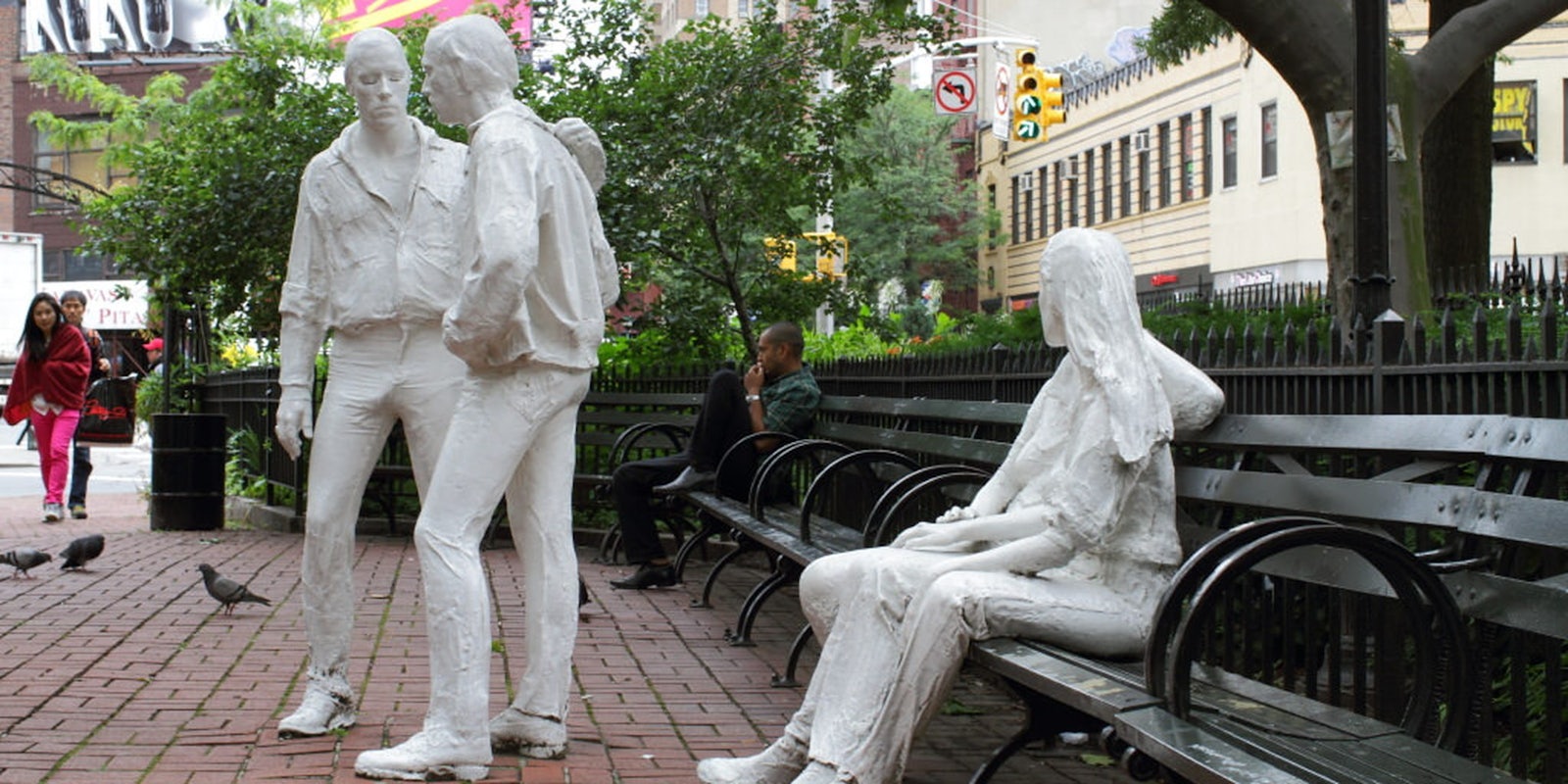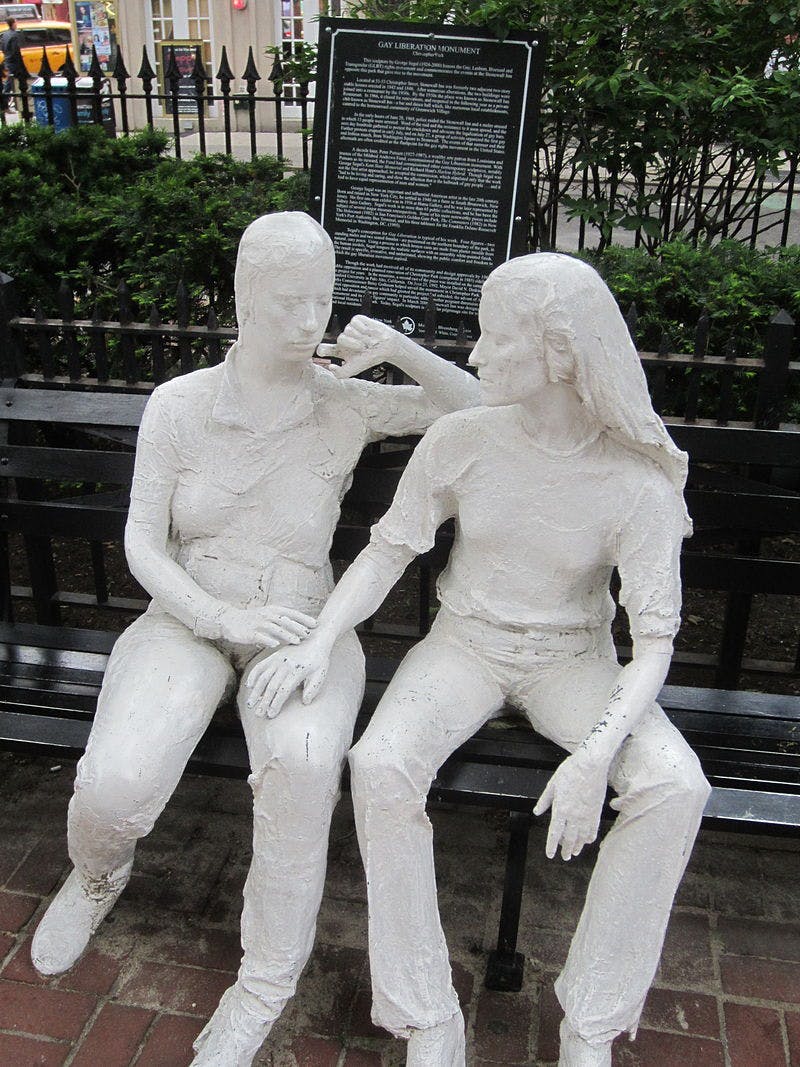Who led the gay rights movement in its early days? White gay men, or black and brown transgender women?
It’s a complex answer, but one thing is clear: trans people of color are noticeably missing from the upcoming Hollywood film Stonewall, directed by Roland Emmerich (Godzilla, Independence Day). In petitions, calls for boycotts, and on social media, the LGBT community has opposed the way the film centers a turning point in LGBT history around a fictional white character while failing to include the real-life people of color that are believed to have sparked the Stonewall riots.
In a response this weekend, two anonymous New York activists took the whitewashing of LGBT history into their own hands by vandalizing a famous sculpture that is permanently housed in a tiny park facing the Stonewall Inn.
The sculpture, titled “Gay Liberation,” was commissioned in 1979 for the famous Pop Art sculptor George Segal. When the work was created, it was considered so controversial and “explicit” (due to its portrayal of two women and two men just barely touching each other) that it wasn’t placed in the public park until 13 years later. At its 1992 unveiling, the city deemed the sculpture a historical monument.
Segal’s sculptural work was highly stylized. After using bandages to create plaster casts of people, he would paint the entire figure stark white. Figures identical to those in “Gay Liberation” were also used in a Holocaust memorial in San Francisco, as well as a campus sculpture at New Jersey’s Montclair State University.
Using Segal’s starkly white figures as an allegory for the whitewashing of LGBT history—particularly at the hands of Stonewall—the two activists painted two of the four statues brown. They also added wigs and colorful costumes to reflect the looks of Stonewall-era trans women like Sylvia Rivera and Marsha P. Johnson.
The two activists spoke on condition of anonymity with Autostraddle on Tuesday. Both queer, gender non-conforming women in their 20s (one Latina, one white), they said their inspiration came from an interview that Autostraddle published with longtime activist Miss Major on Aug. 10. In the interview, Miss Major—a black trans woman who was in the Stonewall riots—bemoaned the whitewashing in the upcoming film and also made direct reference to the Segal installation:
It’s bad enough that across the street from Stonewall, they have statues up to commemorate that night. That’s cute, but there’s not a black statue there! The statues look like they’re made from flour and sugar! What is this? Why can’t one of the girls go up and throw up a little makeup on one of these bitches? And I’m sorry, but the last time I checked, the only gay people I saw hanging around there were across the street cheering. They were not the ones getting slugged or having stones thrown at them. It’s just aggravating. And hurtful! For all the girls who are no longer here who can’t say anything, this movie just acts like they didn’t exist.
That’s all the anonymous protesters needed to throw “a little makeup on one of these bitches” (and of course post a video of the statue-makeover online). In their interview, they explain:
“We painted them because Marsha P. Johnson, Sylvia Rivera, Miss Major, Storme DeLarverie and all the other Black and Brown people who led the movement deserve credit for their courage and strength. What we did was rectification, not vandalism. Those statues are bronze (brown) underneath the layer of white paint — the symbolism behind that is infuriating. I know that some people are going to be angry, but I’m not concerned with preserving bullshit art. I’m angry about the whitewashing of LGBTQ history.”
The activists also had a suggestion for whatever measures the city will take to address the vandalism. “To the people who’ll end up repainting the sculptures: brown and black lacquer exists,” they told Autostraddle. “Think about what it means to repaint the statues white, and then stop.”
Update 8:56pm CT, Aug. 19:
The Daily Dot received the following statement from Assistant Commissioner of Communications Sam Biederman at the New York City Department of Parks and Recreation :
George Segal was one of the most famous sculptors of the latter half of the 20th century. The use of a white surface is typical of much of his work, lending an otherwordly quality that is not intended to be a literal representation of reality.
George Segal’s Gay Liberation monument has been restored. Vandalizing a public sculpture or monument is illegal.
H/T Autostraddle Photo via Paul Stein/Flickr (CC BY 2.0)



